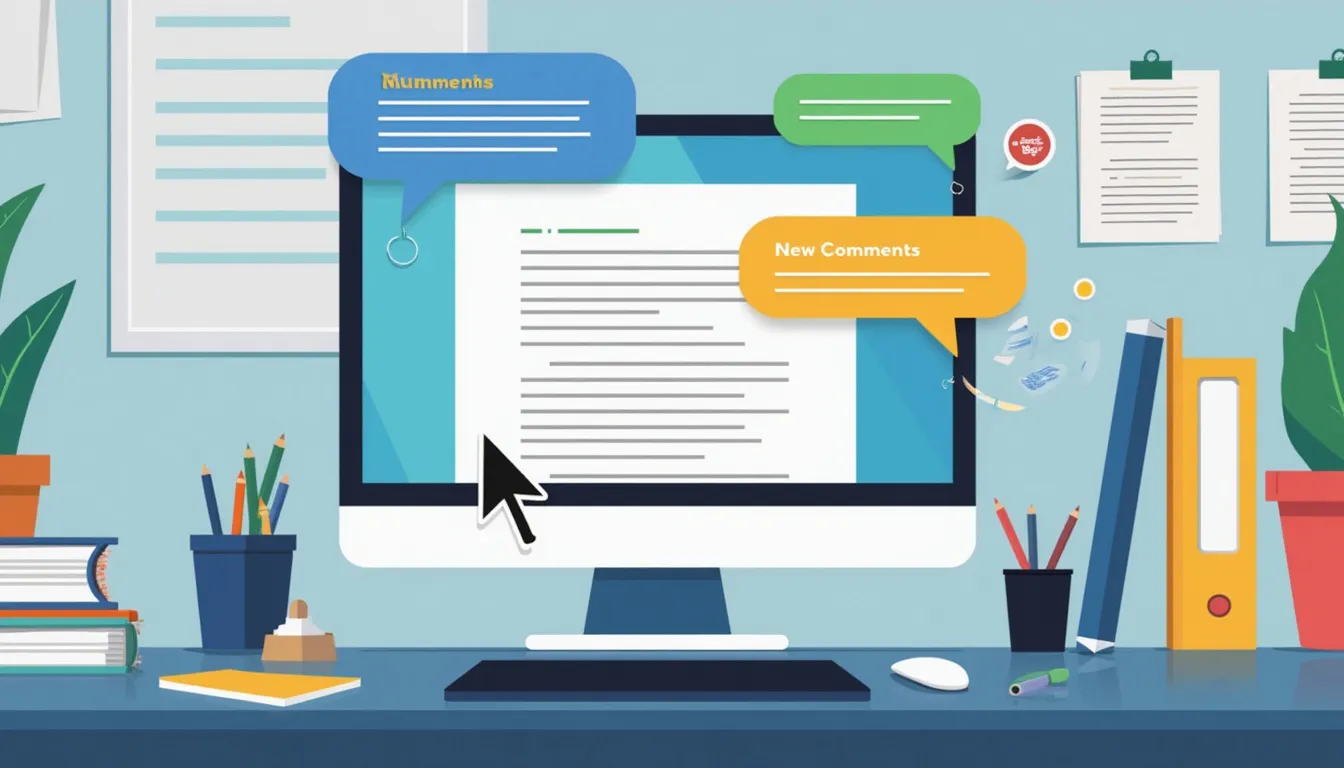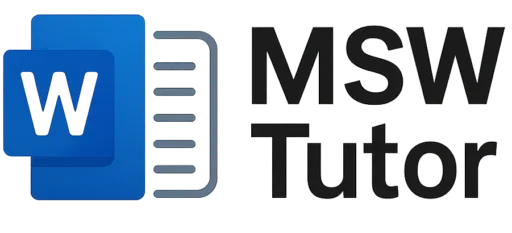Are you tired of sending documents back and forth without clear communication? Well, say goodbye to confusion and hello to smoother collaboration! In this guide, we’ll explore the ins and outs of using comments and suggestions in Microsoft Word, your trusty partner in document editing. With the right tools at your fingertips, enhancing your documents has never been easier. Did you know that effective collaboration can boost productivity by up to 25%?
That’s why mastering comments and suggestions is essential! We’ll cover everything from adding comments with a few simple clicks to making strategic suggestions that elevate your work to the next level. Whether you’re brainstorming with colleagues or refining your masterpiece, you’ll learn best practices to keep feedback focused, clear, and professional. Grab your digital pen and let’s dive into the world of using comments and suggestions in Microsoft Word!
Introduction to Comments and Suggestions in Microsoft Word
Collaboration is the secret sauce of document editing. Whether you’re working with a team or seeking feedback from a friend, using comments and suggestions in Microsoft Word can transform a mere document into a work of art—or at least significantly improve it! In this section, we’ll dive into the features that Microsoft Word provides for enhancing your documents and how they can take your editing game to the next level.
A. Importance of Collaboration in Document Editing
Let’s face it: no one likes working in a vacuum. Collaboration is not only essential for creativity but also for ensuring accuracy and professionalism in your documents. Here are some key reasons why collaboration matters:
- Diverse Perspectives: Collaboration allows you to blend different ideas and viewpoints, leading to a richer document.
- Improved Accuracy: Multiple eyes can catch errors or inconsistencies that you might miss.
- Enhanced Engagement: Involving others boosts investment in the document’s success.
- Efficient Workflows: When using comments and suggestions in Microsoft Word, feedback becomes straightforward and timely, facilitating quicker revisions.
So, it’s clear that collaboration is vital, but how can Microsoft Word help you? Let’s explore the features that enhance your document editing experience.
B. Overview of Features for Enhancing Documents
When we talk about using comments and suggestions in Microsoft Word, we’re referring to powerful tools that can take your document editing from drab to fab. Here’s a quick look at these features:
| Feature | Description |
|---|---|
| Comments | Allows users to add notes, questions, or suggestions in the margins of a document. |
| Track Changes | Records all changes made to a document, providing a clear view of edits made by collaborators. |
| Suggesting Mode | Enables users to propose changes without altering the original text, a crucial aspect of using comments and suggestions in Microsoft Word. |
These features are just the tip of the iceberg. They not only help with editing but also foster a collaborative spirit—amazing, right? Let’s delve deeper into each feature and understand how to effectively utilize them.
C. Best Tools for Collaboration
Beyond comments and suggestions in Microsoft Word, here are additional indispensable tools you may consider to boost your collaboration efforts:
- Microsoft OneDrive: Share your documents and enable real-time collaboration.
- Microsoft Teams: Discuss edits and receive immediate feedback while working on documents.
- Google Docs: For those who prefer cloud-based editing, this platform allows for seamless document collaboration and comment functionality.
But hey, don’t just take our word for it! Check out these resources for a deeper dive:
Once you’re well-versed in using comments and suggestions in Microsoft Word, the sky’s the limit. Stay tuned for the next section on how to effectively use comments, ensuring your document shines like a diamond!

How to Use Comments in Microsoft Word
A. Step-by-step guide for adding comments
Using comments and suggestions in Microsoft Word is a breeze! Here’s how you can spice up your document with insightful comments:
- Open your document in Microsoft Word.
- Select the text where you want to add a comment. Highlighting is key—think of it as setting a stage for your feedback!
- Go to the Review tab on the Ribbon. Trust me, you want to be on this tab.
- Click New Comment in the comments section. Voilà! A comment box appears on the right side of your document.
- Type your comment. Be as witty or as insightful as you like—just keep it constructive, folks!
- Hit the Esc key to save your comments. It’s that simple!
B. Tips for writing effective comments
Once you’ve mastered adding comments, let’s jazz it up a notch. Here are some tips for making those comments as effective as possible:
- Be Clear and Concise: Get to the point! A well-structured comment will save everyone time.
- Use Bullet Points: If your feedback is multi-layered, break it down into bullet points for easy digestion.
- Avoid Jargon: Unless your audience loves technical jargon, keep your language accessible for all!
- Be Positive: Start with favorable observations. A dash of positivity goes a long way in collaboration.
C. Reviewing and resolving comments from others
Now that you’re equipped with the knowledge to add and write comments like a pro, let’s focus on how to handle comments from others. Here’s how:
- Navigate to the Review tab again.
- Click on Next to go through comments sequentially. You can easily see the thrill of feedback-building!
- Decide whether to address each comment:
- If you agree, respond in the comment box or make adjustments in the document.
- If you need clarification, don’t hesitate to communicate in the comments.
- Once you’ve addressed a comment, click on Resolve to hide the comment from the active view. It’s like a celebratory “check” on your to-do list!
Implementing Suggestions in Microsoft Word
A. Overview of the Suggesting Mode
When using comments and suggestions in Microsoft Word, the Suggesting Mode is your best friend. Here’s what it’s all about:
- This mode allows you to provide suggestions that others can view alongside the original text.
- Enable this mode by clicking on the Track Changes option in the Review tab. It’s like putting on your editing glasses!
- All changes will be marked, so your colleagues can see what you’re thinking without any confusion.
B. Making and tracking suggestions effectively
Are you ready to flex your suggestion-making skills? Here’s the lowdown:
- In Suggesting Mode, highlight the text you want to change.
- Type in your suggestion, and it will show up as a different color for easy visibility!
- Add comments where necessary to explain your suggestion; a little context goes a long way.
- Keep track of all suggestions made by going back through the comments section. You’ll feel like a detective piecing together insights!
C. How to accept or reject suggestions in Word
Now, let’s conquer how to accept or reject those brilliant suggestions!
Follow these simple steps to keep your document polished:
- Head to the Review tab again. It’s like your editing command center!
- Locate the changes highlighted in the document. They’ll be so obvious you can’t miss them.
- Click Accept to take in the suggestion or Reject if you have other plans with your text.
- Continue through the document until all suggestions are either accepted or rejected. High-five yourself when you’re done!
By effectively using comments and suggestions in Microsoft Word, you’ll not only improve the quality of your documents but also enhance collaboration with your team. Want to dive deeper into Microsoft Word features? Consider checking out Microsoft’s official support page here for a treasure trove of resources. Happy collaborating!

Implementing Suggestions in Microsoft Word
A. Overview of the Suggesting Mode
When it comes to using comments and suggestions in Microsoft Word, the Suggesting Mode is a game changer. This mode allows you to propose edits without permanently altering the original document. Think of it as your document’s friendly neighborhood “editor” that doesn’t erase anyone’s hard work. To enable this feature, follow these simple steps:
- Open your document in Word.
- Navigate to the Review tab.
- Click on Track Changes to activate Suggesting Mode.
Now, every time you make a suggestion, it will be highlighted, making it clear that these are proposed changes you believe would enhance the document.
B. Making and Tracking Suggestions Effectively
When you’re using comments and suggestions in Microsoft Word, it’s crucial to know how to make suggestions that are clear and actionable. Here are a few expert tips:
- Be Specific: Instead of saying “This needs work,” specify what work needs to be done. For example, “Consider rephrasing this sentence for clarity.”
- Use Clear Language: Avoid jargon or overly complex terms. Aim for language that everyone can understand—think of it as talking to your friend, not your English professor.
- Prioritize Suggestions: If multiple suggestions exist, number them in order of importance. This makes it easier for the original author to follow your recommendations.
Additionally, Microsoft Word allows you to easily track changes visually. Edits will appear in a different color, and you can see who made each change. This is particularly great for teams spread across different locations!
C. How to Accept or Reject Suggestions in Word
Once suggestions are made, the next step is to review them. Imagine this: you just received five brilliant ideas from your colleague, but which ones will you accept? Here’s how to navigate this process with finesse:
- Go to the Review tab.
- Find the Changes section. Here you’ll see options for Accept or Reject.
- Click on the suggestion and choose the appropriate option. You can accept or reject changes one by one, or if you’re feeling bold, accept or reject them all at once!
This process ensures that you’re only incorporating changes that align with your vision for the document, while still being grateful for the input.
Tracking Suggestions: The Table Method
For a more organized approach, you might consider creating a suggestion-tracking table. Here’s a simple format:
| Suggestion | Proposed By | Status |
|---|---|---|
| Rephrase the introduction for clarity | John Doe | Accepted |
| Change font size for better readability | Jane Smith | Rejected |
This table not only helps keep everyone on the same page but also serves as a reference to review what was changed, who suggested it, and whether or not it was implemented. It’s like your document’s very own suggestion “report card.”
Conclusion: Perfecting Your Document with Suggestions
As you put using comments and suggestions in Microsoft Word to practice, remember that collaboration can take your documents from good to great! Embrace the suggestions, and don’t shy away from sharing your insight. By cultivating a constructive feedback culture, you’re setting the stage for stellar documents that reflect the collective genius of your team!
For further tips on collaboration tools and document editing, consider checking out Microsoft’s official support page or Lynda’s learning resources on effective collaboration.
Conclusion
Using comments and suggestions in Microsoft Word can significantly enhance your document editing experience, promoting collaboration and increasing the overall quality of your work. By effectively incorporating comments, you allow your collaborators to add valuable insights and feedback, which can lead to better decision-making and a polished final product. Additionally, the Suggesting Mode provides a clear structure for proposed changes, enabling a transparent review process that fosters teamwork and mutual understanding.
Remember to keep your feedback clear, constructive, and professional to maintain a positive collaboration atmosphere. Utilizing these features can not only streamline your editing process but also improve the final output. So, whether you’re working on a report, presentation, or any document, harness the power of using comments and suggestions in Microsoft Word to create a more effective and engaging product. Happy editing!

